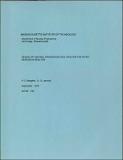Design of central irradiation facilities for the MITR-II research reactor
Author(s)
Meagher, Paul Christopher; Lanning, David D.
Download857230553.pdf (12.17Mb)
Other Contributors
Massachusetts Institute of Technology. Department of Nuclear Engineering
Metadata
Show full item recordAbstract
Design analysis studies have been made for various in-core irradiation facility designs which are presently used, or proposed for future use in the MITR-II. The information obtained includes reactivity effects, core flux and power distributions, and estimates of the safety limits and limiting conditions for operation. A finite-difference, diffusion theory computer code was employed in two and three dimensions, and with three and fifteen group energy schemes. The facilities investigated include the single-element molybdenum sample holder, a proposed double-element irradiation facility and a proposed central irradiation facility design encompassing most of the area of the three central core positions. In addition, a comparison of the effects of various absorber materials has been made for a core configuration which includes three solid dummies. Flux levels in the molybdenum holder facility and in the beam ports were calculated for both three and five dummy cores. Flooding the sample tube in these cases was found to increase the safety and operating limits, but not to unacceptable levels for an 8 inch blade height. For the five dummy case, the operating limit in the C-ring was predicted to reach its maximum allowed value at a blade bank height of 13.6 inches. The reactivity effect of flooding was calculated to be 0.19%AK for the five dummy case, in direct agreement with the measured value. Flooging the large sample channel in the double element facility was found to increase the reactivity by 1.5 6%AK ff and also to cause an unacceptable power-peaking. The proposed central irradiation facility is a thermal flux-trap which could produce thermal flux values of up to 2.0 x 1014 n/cm 2 sec. Computer estimates show that flooding this facility's central sample tube would increase this value to 2.5 x 1014 n/cm2 sec, without resulting in an unacceptable power peak.
Description
"September 1976." Also issued as a Ph. D. thesis by the first author and supervised by the second author, MIT Dept. of Nuclear Engineering, 1977 Includes bibliographical references (pages 94-95)
Date issued
1976Publisher
Cambridge, Mass. : Massachusetts Institute of Technology, Dept. of Nuclear Engineering, [1976]
Series/Report no.
MITNE ; no. 190